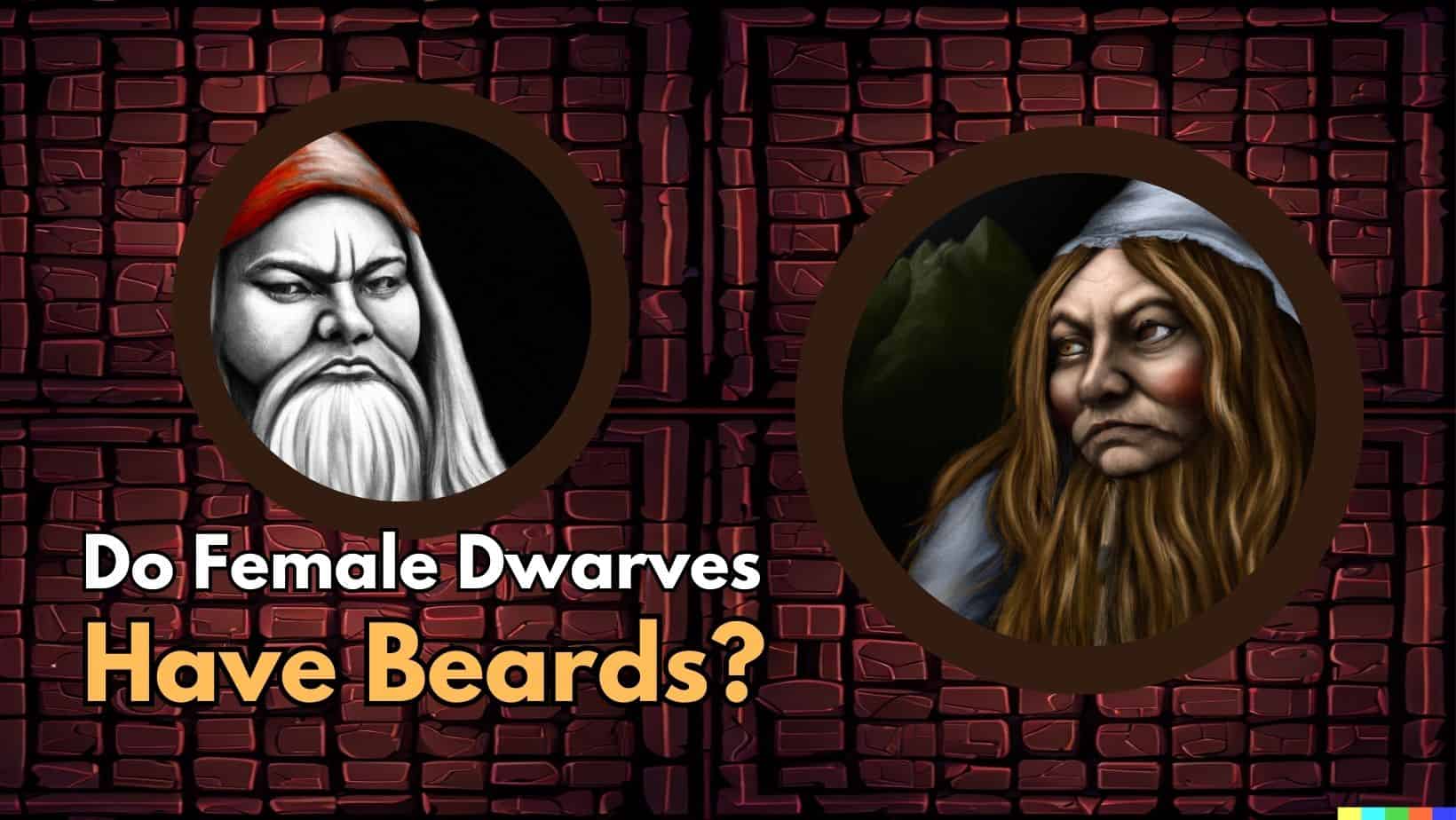Do female dwarves have beards? Want the lowdown on bearded female dwarves? Pull up a chair…
In the multifaceted world of Dungeons & Dragons (D&D), few topics have sparked as much curiosity and debate as the appearance of female dwarves. A particular point of intrigue revolves around the question: Do female dwarves have beards? It’s a query that has tantalized players, Dungeon Masters, and fantasy enthusiasts alike, giving rise to various interpretations and heated discussions.
The origin of this debate can be traced back to the earliest conceptions of dwarves in folklore and literature. Drawing on Norse mythology and the works of seminal fantasy authors like J.R.R. Tolkien, the image of the bearded dwarf became a quintessential trait of dwarvenkind. These descriptions influenced the portrayal of dwarves in D&D lore, establishing a tradition that has been both embraced and challenged over the years.
This article aims to delve into the mystery surrounding female dwarves’ beards in D&D, exploring the topic from various angles. By examining different editions of the game, diverse campaign settings, and cultural interpretations, we will attempt to unravel the complexities of this fascinating subject. Whether viewed as a symbolic representation, a cultural norm, or a personal choice, the question of beards on female dwarves opens a window into broader themes of identity, diversity, and creativity within the game. Our exploration will not seek to dictate a definitive answer but rather to provide insights and perspectives that empower readers to form their own understanding.
Do Female Dwarves have Beards? Traditionally…
The tradition of bearded dwarves is a long-standing one, deeply rooted in mythology, literature, and early role-playing games. This entrenched image is more than a mere aesthetic choice; it embodies the essence of what many perceive dwarves to be: hardy, wise, and tied to the earth. The following sections explore the origin and evolution of this tradition, illuminating how the image of the bearded dwarf came to be an iconic fantasy symbol.
Origins in Norse Mythology
In Norse mythology, dwarves were often depicted as beings crafted from the earth, imbued with a connection to the mountains and minerals. This connection manifested in various physical attributes, including the hallmark beards that became synonymous with dwarven kind. The Prose Edda, one of the primary sources of Norse myth, includes tales of bearded dwarves who were skilled smiths and warriors. The physical portrayal of dwarves in these myths set the stage for future representations, firmly anchoring the image of the bearded dwarf in Western cultural consciousness.
Influence on Fantasy Literature, including Tolkien
The dwarven traditions kept flourishing in modern fantasy literature, most notably through the works of J.R.R. Tolkien. In “The Hobbit” and “The Lord of the Rings,” Tolkien’s dwarves are characterized by their impressive beards, a feature that signifies their wisdom, age, and social status. Authors like Terry Pratchett further contributed to this tradition in their own works. The literary portrayal of bearded dwarves reinforced the image, creating a universal symbol that transcended individual stories and became part of the broader fantasy genre.
Try my AI Tabletop RPG generators...and an extensive library of content!
Dwarven Beards in Early D&D Editions
When Dungeons & Dragons emerged in the 1970s, it drew heavily from existing fantasy literature, including the depiction of bearded dwarves. Early editions of the game embraced this tradition, with artwork and descriptions often showcasing dwarves with elaborately styled beards. This choice reflected not only the influence of literature but also the desire to create a cohesive and recognizable fantasy world. In doing so, D&D helped solidify the bearded dwarf’s place in contemporary fantasy, sparking the curiosity and imagination of players who would later question and expand upon these conventions.
Let’s continue with this track about female dwarf names in Dungeons & Dragons…
Do Female Dwarves Have Beards?… in Various D&D Editions
The depiction of female dwarves, particularly in relation to beards, has evolved and varied across different editions of Dungeons & Dragons. While some editions are ambiguous, others provide more explicit guidance. The shifting portrayal reflects not only the evolution of the game itself but also broader cultural changes and players’ desires for greater diversity and individuality in character creation.
1st Edition: Ambiguity and Assumptions
In the early days of D&D, the 1st Edition provided sparse details about the physical appearance of female dwarves. The primary focus was on racial attributes and abilities, leaving room for interpretation regarding aesthetics. While the imagery of bearded male dwarves was prevalent, there was no specific guidance about female dwarves, leading to assumptions and debates that would persist for years to come.
2nd Edition: Further Exploration
The 2nd Edition of D&D began to explore the subject more explicitly. Some supplemental materials and novels hinted at the possibility of bearded female dwarves, aligning with the broader tradition within the genre. However, inconsistencies and varying opinions among authors and artists left the matter largely open to individual interpretation and preference.
⚔️ Fantasy RPG Random Tables Books
Make life as a Gamemaster easier…
If you play Dungeons & Dragons, Pathfinder, or other fantasy RPGs, this
RPG random tables series
is packed with encounters, NPCs, treasure, and more. Available in eBook or print—either way, you’ll have a wealth of adventure ideas at your fingertips.
3rd to 5th Editions: Diverse Interpretations
With the advent of 3rd, 4th, and 5th Editions, the portrayal of female dwarves continued to diversify. Some settings and materials embraced the bearded aesthetic, while others opted for a different approach. The shift toward more inclusive and customizable character creation allowed players greater freedom to define their characters’ appearance, including the choice of whether a female dwarf might have a beard. The rise of online communities and discussions further fueled this diversity, encouraging an ongoing dialogue that recognizes the multifaceted nature of dwarven culture and identity.
Cultural Interpretations within Different DND Campaign Settings
Dungeons & Dragons is renowned for its rich and varied campaign settings, each offering unique cultures, histories, and characteristics. The portrayal of female dwarves, including the question of beards, varies widely across these settings, reflecting the diverse imaginative landscapes that the game encompasses. This section will delve into three prominent campaign settings: Forgotten Realms, Dragonlance, and Eberron, exploring how each contributes to the multifaceted portrayal of female dwarves.
Forgotten Realms: Prevalence and Significance
In the Forgotten Realms, one of D&D’s most well-known settings, dwarves are often depicted as deeply traditional and tied to ancestral customs. Beards hold significant meaning within dwarven society, symbolizing wisdom, status, and honor. While the portrayal of female dwarves may differ among various sources, some writings and interpretations suggest that female dwarves in this setting may also have beards, emphasizing their connection to these societal values.
Dragonlance: Unique Characteristics
Dragonlance offers a unique perspective on dwarves, with diverse subraces and cultures that manifest in varied physical appearances. In this setting, the question of beards on female dwarves might depend on the specific dwarven community or individual character’s background. Some might embrace beards as a sign of cultural identity, while others may reject or reinterpret this trait. The variety within Dragonlance allows for a nuanced exploration of dwarven identity, providing players with ample opportunities to craft characters that resonate with them.
Eberron: Modern Interpretations
Eberron is known for its blending of traditional fantasy elements with modern themes and sensibilities. In this setting, the portrayal of dwarves, including females, is often more individualized and less bound by rigid traditions. Female dwarves might or might not have beards, and the choice is often presented as a matter of personal preference or stylistic expression. Eberron’s approach reflects a broader shift within D&D toward inclusivity and player agency, recognizing the diverse ways in which individuals might engage with and interpret traditional fantasy tropes.
Conclusion: Do Female Dwarves Have Beards?
This article has embarked on a comprehensive journey through the rich tapestry of dwarven lore in Dungeons & Dragons, focusing on the intriguing question of beards on female dwarves… and beards. From ancient Norse mythology to the latest editions of D&D, and through various campaign settings, we’ve seen how the image of the bearded dwarf has evolved, been challenged, and diversified. We’ve delved into the literary, historical, and cultural underpinnings of this tradition, exploring how different perspectives have shaped the portrayal of female dwarves across the ages.
One of the fundamental insights gleaned from this exploration is the recognition that the question of beards on female dwarves is inherently subjective. It’s a topic that invites personal interpretation and choice, reflecting broader themes of identity, creativity, and diversity within the game. There’s no definitive right or wrong answer, only a rich array of possibilities that allow players and Dungeon Masters to craft characters and stories that resonate with them.
As we conclude, the invitation is extended to all players and Dungeon Masters to continue exploring and defining their own dwarven lore. Whether embracing traditional imagery or forging new paths, the choice is yours to make. Let your imagination soar, guided by the wealth of inspiration that the world of D&D provides. Whether your female dwarves sport magnificent beards or choose a different path, know that the game’s true magic lies in the freedom to create, interpret, and enjoy your unique vision of what it means to be a dwarf.










